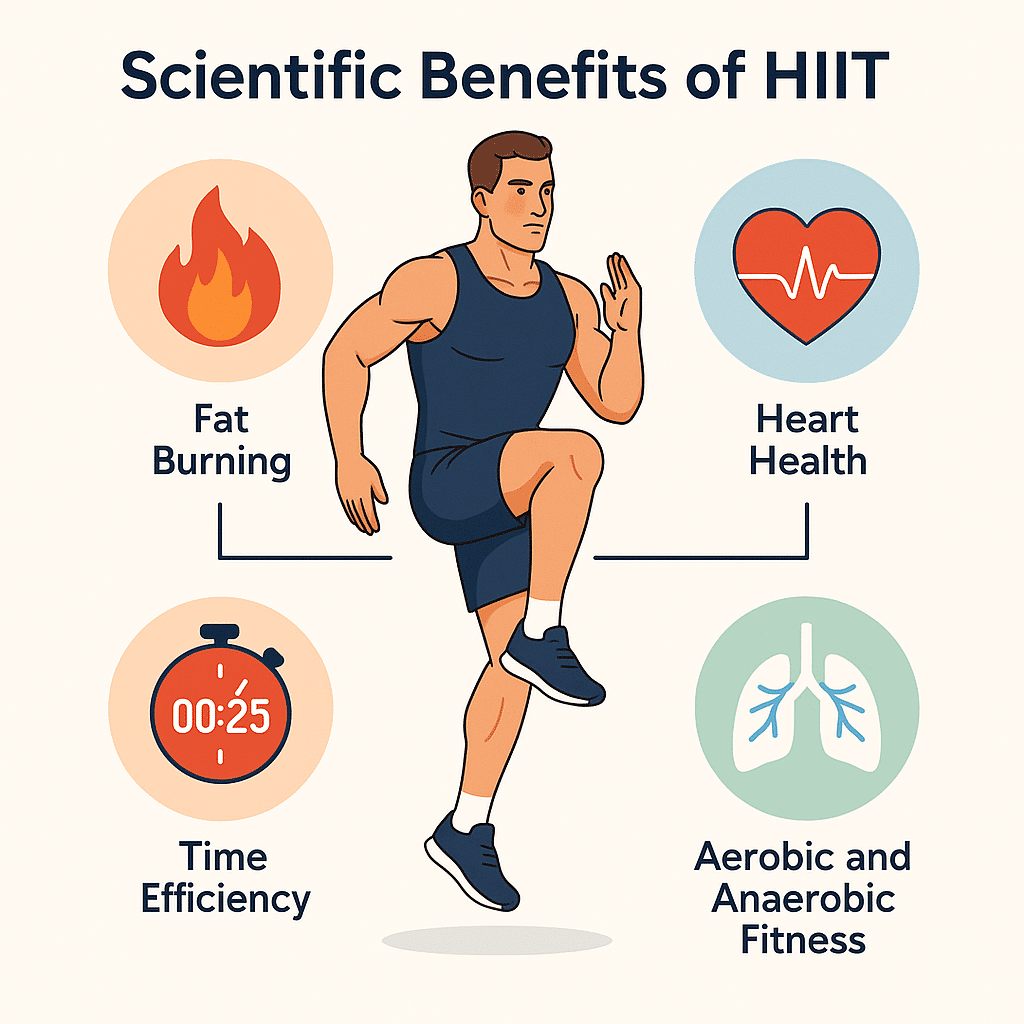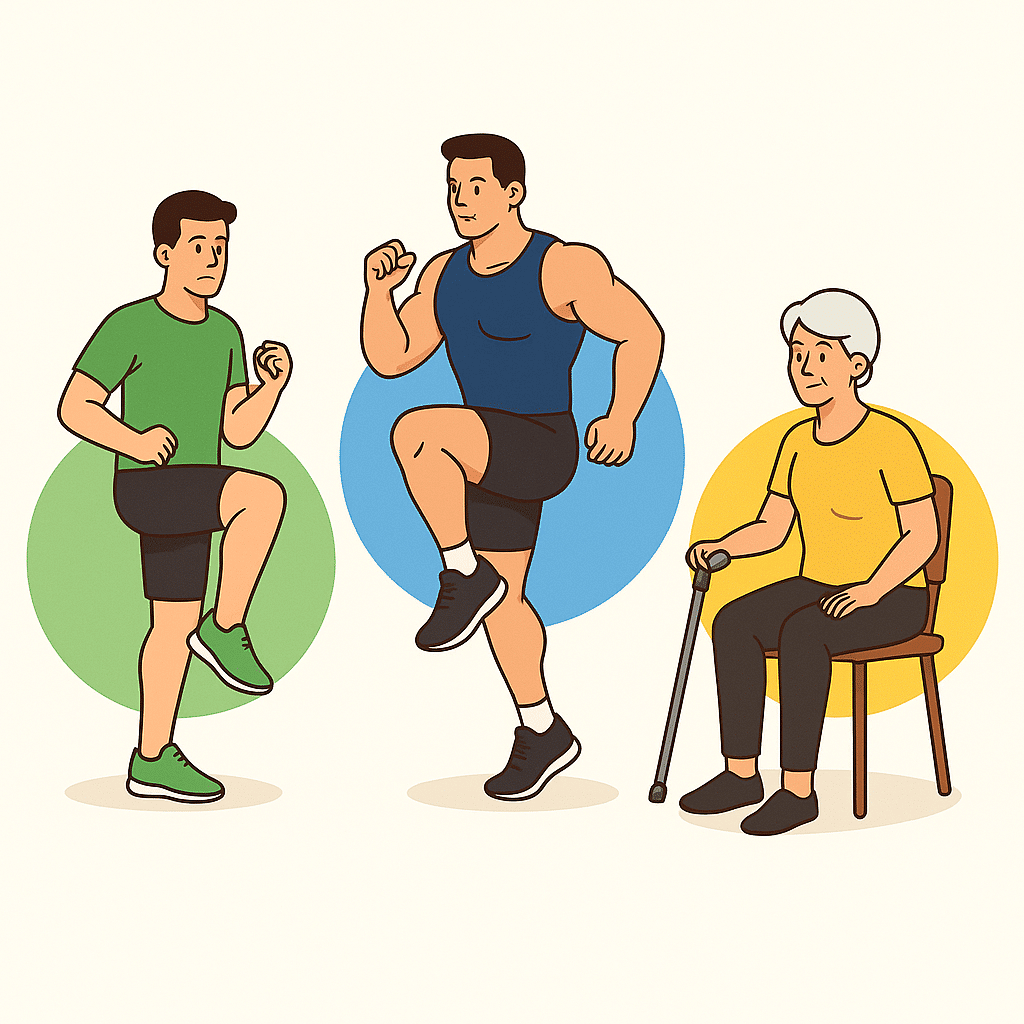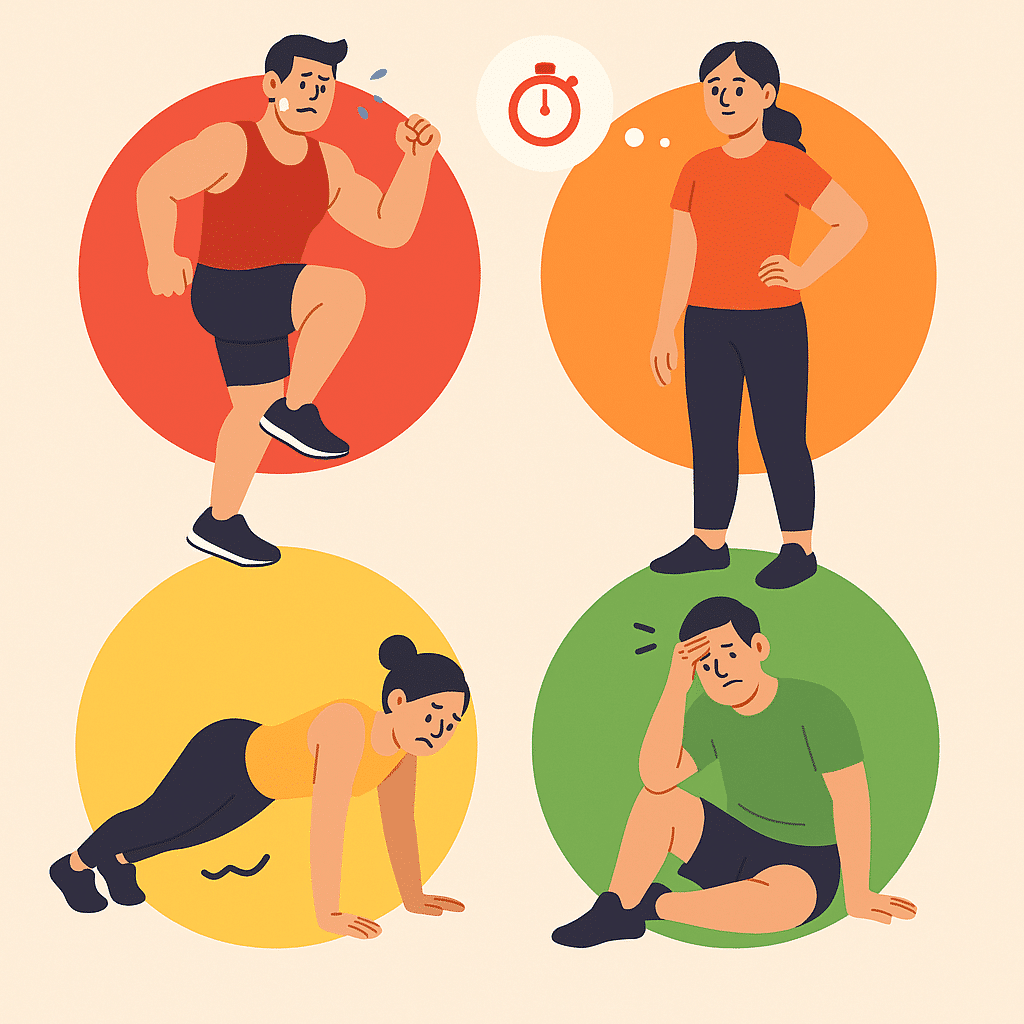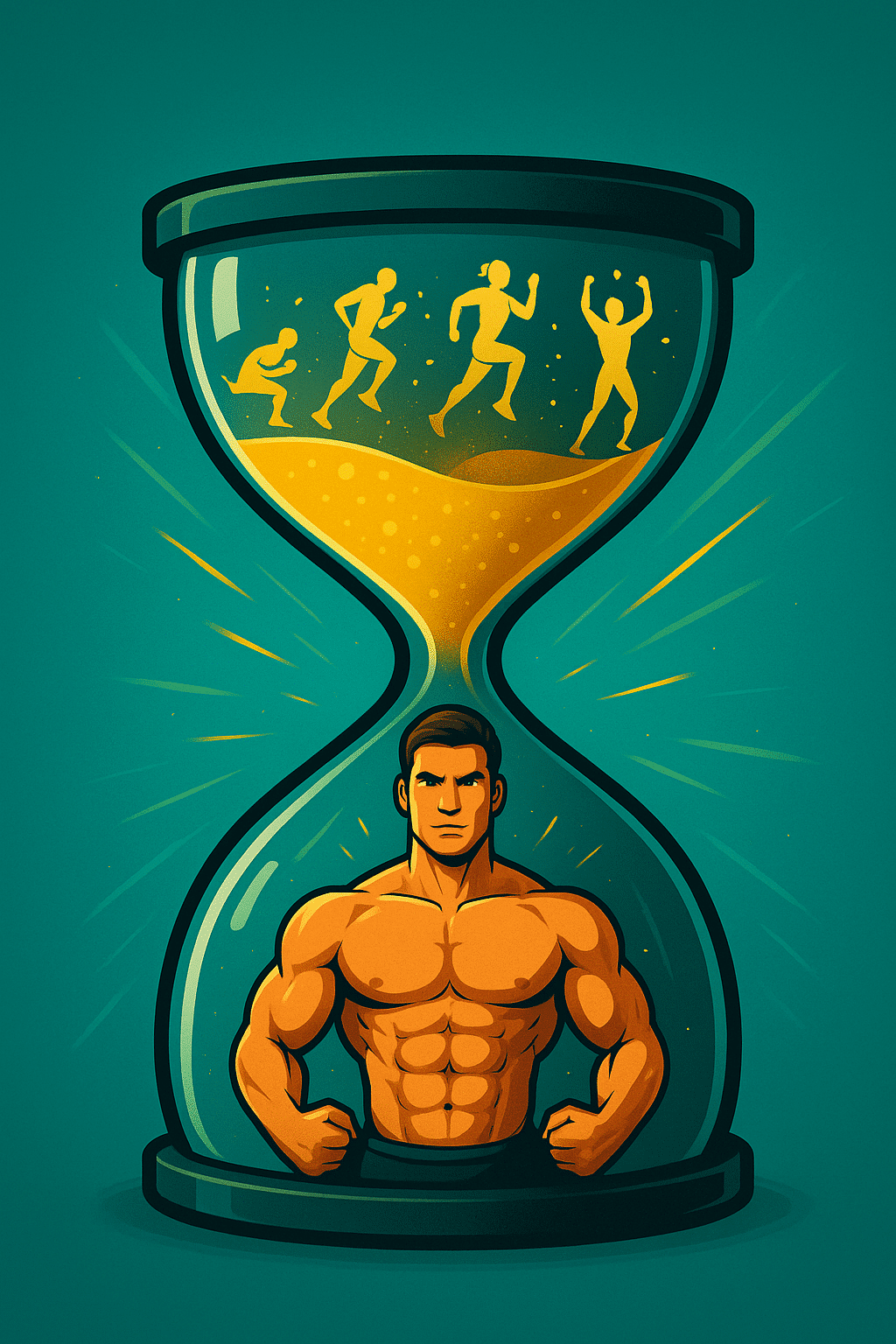High-intensity interval training (HIIT) workouts
HIIT (High Intensity Interval Training)
HIIT (High-Intensity Interval Training) workouts🔥 are a style of exercise in which short periods of intense activity are combined with intervals of rest or low-intensity movement ⏱️. The main goal of this method is to push the body to its maximum capacity in a short amount of time.
Why has HIIT become popular? 💡
In today’s busy world, many people don’t have enough time for long workouts. HIIT offers a quick and effective solution:
In less than 30 minutes, you can do a workout that burns fat, supports heart health ❤️, and improves fitness levels.
For this reason, HIIT is the best choice for those who want remarkable results with minimal time investment.

What is HIIT?
Difference from cardio / intervals
HIIT (High-Intensity Interval Training) workouts, also known as high-intensity interval training, are an innovative approach to exercise that has gained immense popularity among athletes and even beginners in recent years. In this training method, the individual alternates short periods of high-intensity physical activity (such as sprinting, jumping, or explosive movements) with intervals of rest or low-intensity activity.
The core principle of HIIT is to push the body close to its maximum physical capacity during short intervals, and then prepare it for the next round by resting or engaging in light activity. This cycle is repeated several times within a single workout session.

🏃♂️ The difference between HIIT and traditional cardio workouts
In classic cardio workouts such as walking, jogging, or cycling at a steady pace, the intensity is usually moderate and the duration of the workout is relatively long. In this method, the heart rate remains fairly constant throughout the session, and the body expends energy at a steady rate.
However, in HIIT, the intensity of activity spikes sharply during short intervals, causing the heart rate to rise suddenly. This is followed by a recovery period (light activity or rest) to allow the body to return to normal. This pattern of high intensity followed by rest elevates the body’s metabolism even after the workout is over (known as the afterburn effect or EPOC), which is one of the main reasons HIIT leads to greater fat burning and improved fitness.
🔄 Work and rest intervals
Each HIIT session typically consists of several “cycles.”
Each cycle consists of two main parts:
Work Interval:
In this phase, the athlete performs an explosive or high-intensity movement at maximum or near-maximum effort (e.g., 20 to 40 seconds of sprinting, jumping jacks, burpees, or jump squats).Rest/Recovery Interval:
After the intense phase, a short period is allotted for full rest or very light activity (e.g., 30 to 60 seconds of slow walking or standing still).
These work and rest cycles are usually repeated 4 to 10 times, and the total workout duration varies from 10 to 30 minutes depending on the individual’s fitness level.
✅ In summary
HIIT is a method designed to maximize workout effectiveness in a short period of time, increase calorie burn, improve cardiovascular and muscular performance, and help busy individuals stay motivated. These qualities have made HIIT one of the most popular and effective training methods today.
Scientific benefits of HIIT
Fat burning / time efficiency / heart health / aerobic and anaerobic benefits
🔥 Faster fat burning
One of the main reasons for HIIT’s popularity is its significant impact on accelerating fat loss. Multiple studies have shown that HIIT workouts can burn more calories in less time compared to steady-state aerobic exercises (such as running at a constant pace).
Besides calorie burning during exercise, HIIT increases the phenomenon of EPOC (Excess Post-Exercise Oxygen Consumption), or the “afterburn effect,” meaning the body continues to burn calories for several hours after the workout, maintaining a higher-than-normal metabolism. For example, a study published in the journal Obesity (2012) showed that participants who performed HIIT lost more abdominal fat over several weeks compared to the control group (1).

⏱️ Time efficiency
One of the greatest advantages of HIIT is its high effectiveness in a short amount of time. A typical HIIT session usually lasts between 15 to 30 minutes but, due to its high intensity, it is as effective as or even more effective than traditional 60-minute workouts.
Multiple studies, including research published in PLOS One (2014), have shown that even very short HIIT programs (e.g., three 20-minute sessions per week) can improve health markers as much as longer classic aerobic exercises (2).
This feature makes HIIT ideal for people with busy lifestyles, enabling them to achieve desirable results without spending a lot of time.
❤️ Positive impact on heart health
Contrary to what many people believe, HIIT workouts are not harmful to heart health; in fact, they can significantly improve cardiovascular function.
HIIT causes the heart rate to intermittently increase to near its maximum capacity and then return to a resting state. This cardiovascular challenge over time strengthens the heart muscle, improves pumping efficiency, and increases aerobic capacity.
A meta-analysis published in the British Journal of Sports Medicine (2018) showed that HIIT significantly improves aerobic capacity and heart health in patients with coronary artery disease, provided that safety guidelines are followed (3).
💨 Improved aerobic and anaerobic performance
In addition to enhancing aerobic endurance (the body’s ability to supply oxygen to muscles during prolonged activity), HIIT is also highly effective in improving anaerobic capacity (the body’s ability to produce energy without oxygen during short, intense bursts).
A study published in Medicine & Science in Sports & Exercise (2008) found that participants who performed HIIT experienced significant increases in VO2max (maximum oxygen consumption) as well as anaerobic power (4).
These achievements make HIIT an efficient tool for improving fitness levels not only for professional athletes but also for the general population.
📊 Scientific studies and statistics (with references)
Obesity (2012): Examined the effect of HIIT on abdominal fat burning and increased EPOC. Result: HIIT led to a significant reduction in abdominal fat compared to traditional aerobic exercise.
PLOS One (2014): Compared HIIT with traditional aerobic exercise in terms of time commitment and effectiveness. Result: HIIT produced similar or even better effects in less time.
British Journal of Sports Medicine (2018): Meta-analysis of HIIT in cardiac patients. Result: HIIT led to significant improvements in cardiac and aerobic capacity.
Medicine & Science in Sports & Exercise (2008): Examined the impact of HIIT on VO₂max and anaerobic capacity. Result: Significant improvement in both indicators.
Who can do HIIT?
Beginners / athletes / individuals with limitations
Due to its flexible structure and the ability to adjust intensity and duration, HIIT can be a suitable option for a wide range of people. However, following certain safety guidelines and precautions is key to gaining the healthy and effective benefits of this type of workout.

🟢 Beginners
Beginners can also benefit from HIIT, provided they start with lower intensity and shorter durations. It’s recommended to begin with fewer repetitions and longer rest periods. Learning proper exercise form and doing a thorough warm-up beforehand is especially important.
🔵 Athletes
For semi-professional and professional athletes, HIIT is a powerful tool for boosting aerobic and anaerobic capacity, burning fat, and enhancing performance. Many professional athletes incorporate HIIT into their training routines to add variety and improve their overall fitness indicators.
🟡 Individuals with limitations or special conditions
Individuals with specific medical conditions (such as heart disease, high blood pressure, diabetes, severe obesity, or musculoskeletal injuries) should consult a doctor or health professional before starting any HIIT program.
For older adults or those with a history of joint or respiratory issues, it is essential to adjust the intensity and choose low-impact exercises. Even in these cases, with proper modifications, HIIT can be part of a rehabilitation or health improvement plan.
⚠️ Warnings and precautions
Cardiac or respiratory issues: Individuals with heart or lung conditions must obtain medical clearance and guidance from their doctor before starting HIIT.
Current injuries: If there is an active muscle, joint, or bone injury, it should be fully treated first. Gradual return to HIIT should only occur under the supervision of a specialist.
Older adults: Seniors can benefit from HIIT if they have a basic level of fitness and professional supervision. However, the intensity of exercises and rest durations must be adjusted according to their individual conditions.
Pregnancy: Pregnant women should only participate in certain aspects of HIIT with their doctor’s approval and supervision, and preferably by choosing very gentle and low-impact exercises.
Conclusion
HIIT can be performed by most people, provided safety guidelines are followed, appropriate intensity is chosen, and professional advice is sought when necessary. This style of training can be tailored to each person’s fitness level, age, and medical condition to ensure both safety and effective results.
Key points before starting HIIT
Warm-up / intensity selection / importance of rest / hydration
🔸 Proper warm-up
Starting each HIIT session with a focused and proper warm-up is extremely important. Warm-up exercises (such as brisk walking, dynamic stretching, jumping jacks, or gentle lunges) raise body temperature, increase blood flow to the muscles, and prepare the central nervous system for intense movements. This greatly reduces the risk of muscle and joint injuries.

🔸 Choosing appropriate intensity and duration
The intensity of HIIT workouts should be adjusted according to the individual’s fitness level, age, and medical history. Beginners are advised to start with shorter intervals (such as 20–30 seconds of intense activity) and longer rest periods. More experienced athletes can increase the intensity or length of the work intervals.
It’s important that individuals without prior experience do not start at maximum intensity and instead gradually increase the intensity of their workouts over time.
🔸 The importance of rest between sets
Rest or recovery intervals between the high-intensity phases of HIIT play a key role in both safety and workout quality. Sufficient rest (active or passive) allows heart rate and breathing to decrease somewhat and gives the muscles time to recover for the next set. Reducing rest periods too much can lead to excessive fatigue, lower exercise quality, and a higher risk of injury.
🔸 Hydration and recovery
HIIT leads to sweating and fluid loss, so it’s important to drink enough water before, during, and after your workout. Additionally, proper recovery (cooling down with gentle movements, stretching, and taking adequate rest between training sessions) helps with muscle repair and reduces the likelihood of muscle soreness.
Neglecting recovery can lead to reduced performance, injury, or even a loss of motivation to exercise.
Summary
Proper warm-up, appropriate intensity and duration, adequate rest, and attention to hydration and recovery are the keys to safety and success in HIIT workouts. These factors help you get the most out of your training without injury or burnout.
Sample HIIT workout program for home
Without equipment / Exercise structure / Suggested movements
⏰ Introduction
This HIIT program is designed for individuals who want to get the most out of their workouts at home, without the need for special equipment, and in the shortest amount of time. All you need is 20 minutes and motivation!

📋 Workout structure
Total duration: 20 minutes
Pattern: 30 seconds of intense exercise + 30 seconds of rest
Number of movements: 5 different exercises
Repetitions: Perform each movement for 3 rounds (a total of 15 active sets).
💪 Suggested movements
1. Jump Squat
2. Burpee
3. Jumping Jack
4. Mountain Climber
5. Push-Up / Plank
📊 HIIT Workout Program Table
|
Round |
Movement 1 |
Movement 2 |
Movement 3 |
Movement 4 |
Movement 5 |
|---|---|---|---|---|---|
|
Round 1 |
Jump Squat |
Burpee |
Jumping Jack |
Mountain Climber |
Push-Up |
|
Round 2 |
Jump Squat |
Burpee |
Jumping Jack |
Mountain Climber |
Plank |
|
Round 3 |
Jump Squat |
Burpee |
Jumping Jack |
Mountain Climber |
Push-Up |
|
Time |
30 seconds |
30 seconds |
30 seconds |
30 seconds |
30 seconds |
After each 30 seconds of exercise, rest for 30 seconds. After completing all 5 movements, proceed to the next round.
⚠️ Execution Tips
- Before starting the workout, perform 3 to 5 minutes of dynamic warm-up.
- Make sure to rest between each movement and each round.
- Drink water and pay attention to proper form during the movements.
- If you’re a beginner, reduce the intensity or extend the rest time slightly.
- After finishing the workout, perform 3 minutes of stretching to cool down your body.
📝 Summary
This short and effective HIIT program is suitable for all fitness levels and can be done in any space. Just stay consistent, and you’ll quickly feel positive changes in your body and daily energy levels.
Common Mistakes in HIIT and Solutions
Overtraining / Neglecting Warm-Up and Cool-Down / Choosing Incorrect Movements / Not Allowing Enough Rest
Although HIIT workouts are highly effective and engaging, they can be harmful or less effective if proper principles are not followed. Being aware of common mistakes and practical solutions to avoid them is key to maximizing productivity and safety in this type of training.

🟥 1. Overtraining
Mistake: Many people, due to the high impact of HIIT, are tempted to increase the number of sessions or the intensity of the workouts excessively. This can lead to fatigue, chronic muscle pain, performance decline, weakened immune system, or even injury.
Solution:
- Perform HIIT a maximum of 2 to 4 times per week.
- Give your body time to recover and don’t forget to include light workout or rest days.
- Take signs of excessive fatigue or persistent pain seriously.
🟧 2. Neglecting Warm-Up and Cool-Down
Mistake: Some people skip warming up before and cooling down after HIIT; however, lack of muscle and nervous system preparation increases the risk of injury and muscle cramps.
Solution:
Always perform 3 to 5 minutes of dynamic warm-up before HIIT (dynamic stretches, brisk walking, jumping jacks).
After the workout, perform 3 to 5 minutes of stretching and light cool-down exercises to facilitate muscle recovery.
🟨 3. Choosing Incorrect Movements
Mistake: Using overly complex or heavy movements beyond one’s fitness level, or performing exercises with improper technique, can lead to injury and reduce workout effectiveness.
Solution:
Choose movements according to your fitness level; beginners should start with simpler exercises.
Focus on proper form and execution quality, not just speed or the number of repetitions.
If needed, use a coach or trusted resources to learn the correct technique for movements.
🟩 4. Not Allowing Enough Rest
Mistake: Shortening rest periods or neglecting their importance leads to premature fatigue and reduces the quality of subsequent sets.
Solution:
- Stick to the recommended time ratios (e.g., 30 seconds of exercise, 30 seconds of rest).
- If you feel extreme fatigue or unusual shortness of breath, take longer rest periods.
- The quality of each movement is more important than completing the workout without rest.
📝 Summary
Avoiding these mistakes and following practical solutions ensures that your HIIT workouts are both safer and more effective. The goal is gradual progress and long-term health, not burnout or injury!
Difference Between HIIT and Other Training Methods
HIIT vs. Steady-State Aerobic Exercise (Endurance Cardio)
HIIT workouts, as a modern training style, have significant differences compared to other common methods such as steady-state aerobic exercise and traditional weight training. Understanding these differences helps in making more informed choices and achieving fitness goals more effectively.

🏃♂️ HIIT vs. Steady-State Aerobic Exercise (Endurance Cardio)
Steady-state aerobic exercises (such as running at a steady pace, long walks, or gentle cycling) are usually performed at moderate intensity and for longer durations. In this style, the heart rate stays within a steady range, and fat burning occurs during the exercise.
In contrast, HIIT combines short bursts of very intense activity with rest periods, repeatedly raising and lowering the heart rate to its maximum. This pattern of alternating intensity not only burns more calories in less time but also increases the afterburn effect (EPOC), promoting fat burning even after the workout.
|
Comparison |
HIIT |
Steady-State Aerobic Exercise |
|---|---|---|
|
Exercise Intensity |
Very High (Interval) |
Moderate (Steady) |
|
Duration |
Short (15-30 minutes) |
Long (30-60 minutes or more) |
|
Fat burning |
High, even after exercise |
During exercise |
|
Impact on cardiovascular fitness |
Very high |
Good, but much lower |
|
Variety of movements |
High |
Limited (running, cycling, etc.) |
|
Suitable for busy individuals |
Yes |
Less |
🏋️♂️ HIIT vs. Traditional Weight Training
Traditional weight training is based on specific sets and repetitions, using weights, and is often aimed at increasing strength and muscle mass. The intensity of the workout is controlled by the weight and the number of repetitions, and typically involves longer rest periods.
In HIIT, the focus is on high intensity, heart rate, and minimizing rest time. Strength movements can also be incorporated intermittently in HIIT, but the main goal is to simultaneously enhance strength, endurance, and fat burning.
|
Comparison |
HIIT |
Traditional Weight Training |
|---|---|---|
|
Type of Exercise |
Aerobic and Strength |
Strength (Muscle-focused) |
|
Activity Intensity |
Very High (Interval) |
Adjustable (usually moderate or high) |
|
Rest Time |
Short (in seconds) |
Longer (1-3 minutes) |
|
Calorie Burning |
Very high |
Moderate (depends on workout volume) |
|
Main Focus |
Fat burning, overall fitness |
Increase in strength and muscle mass |
|
Suitable for all levels |
Yes (Adjustable) |
Requires a stronger technical foundation |
Summary Comparison Table
|
Features |
HIIT |
Steady-State Aerobic Exercise |
Traditional Weight Training |
|---|---|---|---|
|
Intensity |
Very High (Interval) |
Moderate (Steady) |
Moderate/High (Muscle-focused) |
|
Duration |
Short |
Long |
Variable |
|
Calorie Burning |
Very high |
High (during exercise) |
Moderate |
|
Increase in strength |
Moderate/High |
Low |
High |
|
Increase in aerobic endurance |
Very high |
High |
Moderate |
|
Recovery and Rest |
Short |
Less required |
Longer |
|
Suitable for busy individuals |
Yes |
No |
Depends on the program |
📝 Summary
HIIT, as a flexible and time-efficient training method, is suitable for quick fat burning, improving heart health, enhancing aerobic fitness, and increasing physical strength. However, each training method has its own unique features, and the choice should align with individual goals, physical condition, and preferences.
Conclusion and Practical Recommendation
Summary of Benefits / Quick Start Tips
✅ Summary of Benefits
HIIT workouts are among the most efficient exercise methods for fat burning, improving cardiovascular fitness, and increasing both aerobic and anaerobic performance. This style of training is particularly a smart and scientific choice for individuals with limited time, and due to its high flexibility, it can be adjusted for all fitness levels.

🏁 Quick Start Tips
To get started, simply try a basic program like the 20-minute HIIT routine without equipment.
Start with a short warm-up.
Choose five simple movements (such as jump squats, burpees, jumping jacks, mountain climbers, and push-ups).
Perform each movement for 30 seconds with intensity, then rest for 30 seconds.
Repeat this cycle for three rounds, and at the end, do a few minutes of stretching.
Invitation to Exercise
Try the home HIIT program today! You can download or save the suggested program from this article and track your personal progress. If you need more workouts and guidance, feel free to visit the educational resources or free HIIT program on the Planck website.
Frequently Asked Questions (FAQ)
HIIT Workouts
1. Is HIIT better for weight loss?
Yes, HIIT, due to its high intensity and afterburn effect (EPOC), can burn more fat in less time compared to steady-state aerobic exercises.
2. How many times a week should HIIT be done?
For most people, 2 to 4 HIIT sessions per week are sufficient and safe. Doing more than this can lead to fatigue or injury.
3. Is HIIT suitable for women?
Yes, HIIT is absolutely suitable for women and can help with weight loss, body shaping, and improving heart health. The intensity and type of exercises should only be chosen according to one's fitness level.
4. Can beginners do HIIT?
Yes, but beginners should start with simpler exercises, shorter durations, and longer rest periods. Proper form is more important than high intensity.
5. Does HIIT require equipment?
No, most HIIT programs can be done without equipment (using body weight). However, adding dumbbells, bands, or other tools is possible for more variety.
6. Does HIIT increase muscle mass?
HIIT mainly focuses on fat burning and improving endurance, but some strength exercises can also aid in muscle growth. If the main goal is to increase muscle mass, weight training should complement HIIT.
7. Is HIIT dangerous for heart health?
In healthy individuals, HIIT is not only safe but beneficial. However, those with heart conditions or underlying health issues should consult a doctor before starting.
8. How long should a HIIT session be?
Most HIIT programs last between 15 to 30 minutes. Longer sessions are not necessarily more effective and can even be harmful.
9. What happens if we decrease or increase the rest time between exercises?
Decreasing rest time increases the intensity of the workout, but it may cause form to deteriorate and increase the risk of injury. Increasing rest makes the workout lighter but safer; balance is key.
10. Is HIIT suitable for all ages?
Yes, with general health and proper intensity levels, HIIT is suitable for all ages. Even older adults can perform modified, lighter versions of HIIT with guidance from a specialist.
References
- تأثیر تمرینات تناوبی با شدت بالا بر کاهش چربی
High-Intensity Intermittent Exercise and Fat Loss - Systematic Review: The Impact of HIIT on Health Indicators
A Systematic Review: The Impact of HIIT on Health Outcomes - HIIT for Cardiovascular Disease Patients: A Meta-Analysis
HIIT for Cardiovascular Disease Patients: A Meta-Analysis - اثرات HIIT بر بهبود عملکرد هوازی و بیهوازی
HIIT Improves Aerobic and Anaerobic Performance - HIIT: Science and Application
HIIT: Science and Application - High-intensity interval training: Is it right for you?
High-intensity interval training: Is it right for you? - تمرینات تناوبی برای قلبی قویتر
Interval training for a stronger heart - مزایای HIIT برای کاهش چربی و بهبود حساسیت به انسولین
Benefits of HIIT for Fat Loss and Insulin Sensitivity - برنامههای HIIT مخصوص مبتدیان در خانه
Beginner HIIT Workouts You Can Do at Home - HIIT: Evidence and Guidelines
HIIT: Evidence and Guidelines
Pelank Life | Body Health Assessment
The Best Body Health Calculators Using Scientific Methods
Developed by Pelank Life ©